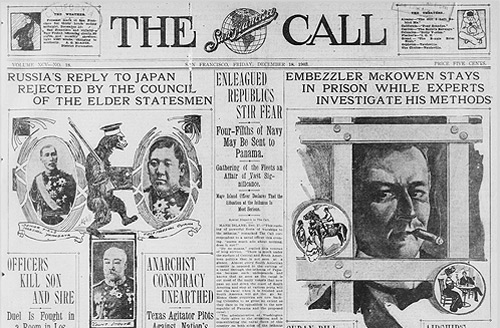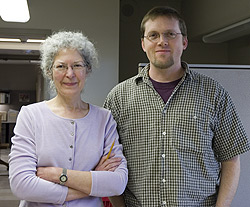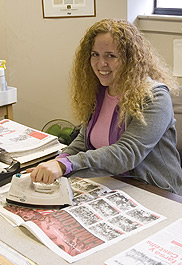Berkeleyan
 The CNP is providing digitized copies of the San Francisco Call, dated 1900 to 1910, for a national project called American Chronicle. Staunchly Republican for much of its life, and popular with working-class readers, the Call — founded in 1856 as the Daily Morning Call — was San Francisco's leading morning newspaper for several decades in the late 19th century. This front page is dated Dec. 18, 1903. |
California Newspaper Project - read all about it!
For ambitious UC collaboration, Golden State journals are a resource to preserve and protect
![]()
| 17 January 2007
If journalism is the first draft of history, as the saying goes, then neglecting California's long and robust newspapering tradition - by allowing many of its 10,000-odd papers to go unaccounted for and perishable back editions to mold and crumble - would be a devastating loss for future historians and generations. That's the driving idea behind the California Newspaper Project (CNP), a long-running effort to track down, catalogue, and in many cases preserve and make readily accessible thousands of California papers that have rolled off the presses since the state's beginnings.
California, unlike some states, has had "no central repository for newspapers," says librarian Andrea Vanek, CNP's manager, who started with the project in 1992 for what she thought was at most a two-year stint. "Some states have a comprehensive published history of their newspapers, a bibliography, and a firm grasp of who has what."
Initiated by UC Riverside history professor Henry Snyder in 1991 at that campus's Center for Bibliographical Studies and Research, CNP is the state component of the U.S. Newspaper Program - funded by the National Endowment for the Humanities and managed by the Library of Congress - which seeks to preserve America's newspapers. "Newspapers are the most important printed record for local history in the U.S.," Snyder says. "They are the most-used media held by local libraries, used by everyone from schoolkids doing homework up to seniors doing genealogical research."
Scouring the state
Since its inception, CNP has sent teams of UC librarians, Vanek among them, to the far corners of California. Their goal: to create a comprehensive database of all the general-interest newspapers published since the state's beginnings, with information on where copies of these publications can be found. Thanks to her CNP forays to scores of Northern California communities, and intimate familiarity with the project's database, Vanek readily reels off the names of newspapers past and present: Woodland Daily Democrat, Williams Farmer, Davis Enterprise, Arbuckle American, Colusa Sun, Orland Unit, Redding Searchlight, Red Bluff News.
 Librarian Andrea Vanek and staffer Tom McMurdo have visited scores of towns throughout the state to locate general-interest newspapers for the California Newspaper Project. (Deborah Stalford photo) |
In all, CNP staff have visited more than 1,400 repositories - historical societies, archives, newspaper morgues, minor and major libraries, and private citizens' cobwebbed basements and attics. "And we're still hearing about places we missed," says Snyder, who traveled the length of Highway 49 to inventory the state's mountain region. A memorable moment in that sleuthing effort was meeting the publisher of the Sierra Booster, who had put out that paper for half a century and continued to deliver it by plane to remote communities until his death at 94. Snyder also discovered that he himself comes from a long line of California newspaper editors, beginning with his great- great-great grandfather, who arrived in California by covered wagon and founded five local papers during his lifetime.
CNP staffer Tom McMurdo recalls tracking down a two-decade run of a Kern County newspaper, the Boron Enterprise, stacked floor-to-ceiling in an elderly resident's home, and arranged for its donation to the Twenty Mule Team Museum in town. While surveying another Southern California historical society, he discovered one of the earliest issues of the state's first newspaper - The Californian of Monterey, started in 1846, four years before California was admitted to the Union - stuffed in the bottom of a cardboard box, and advised archivists of his valuable discovery. (The Californian later moved to San Francisco and became the Daily Alta California, one of the papers available on CNP's website.) "A lot of times people don't have a clue of what they have in their collections," McMurdo notes.
Preservation for posterity
So far, CNP has catalogued close to 10,000 papers published in some 40 languages. Not surprisingly, the Bancroft and other libraries at Berkeley - which together hold about 5,000 newspapers, half of them from California - have come to play an important role in the preservation endeavor. Vanek and McMurdo have been working for a number of years out of Doe Library, in close collaboration with Library Preser-vation Department staff.
 Roxanne Mintz, '06, had a senior-year job in Doe Library preparing newspaper pages for microfilming - one step in the labor-intensive process of preserving historic newspapers for posterity.(Deborah Stalford photo) |
Tom Leonard, Berkeley's University Librarian and a professor of journalism, calls the California Newspaper Project "an example of the UC campuses doing something cooperative for the greater good." Because an increasing number of newspaper companies are financially strapped, their capacity to preserve their own back files is diminished, he says. "We're making sure that California newspapers get in an archived situation where . that material will be available to scholars in the future, as well as to people researching family history." Leonard notes that CNP has attracted an "astonishing" amount of funding - about 8 million in state and federal dollars.
While some California newspapers are gone forever ("We don't have a single surviving issue," Snyder says), and others exist only in their original newsprint form, vulnerable to decay, CNP has had considerable success in getting funding to permit microfilming of endangered papers. The project's "greatest achievement," in Snyder's opinion, has been securing some 80,000 reels of microfilm, or about 40 million newspaper pages, in safekeeping for the public. (When commercial vendors own these resources, it's often prohibitively expensive to get a copy.) Newspapers preserved on microfilm can last as long as 500 years, and a high-quality microfilm can yield, in turn, a great digital image.
Hard news, serialized novels, and hypnotist ads
Sometime in February, American Chronicle, a new website dedicated to the history of U.S. newspapers, is scheduled to debut. That Library of Congress/National Endowment for the Humanities collaboration will eventually post online a selection of historical newspapers from all 50 states. Six states, California among them, were funded to contribute to the initial offering, focusing on the first decade of the 20th century. Upon consultation with historians familiar with the period, CNP is digitizing the Call (75,000 pages worth) as well as two smaller papers of that era, the Amador Ledger, from the Gold Country, and the Imperial Valley Press, whose pages chronicle the birth of a farming community out of the desert east of Los Angeles. (California contributions to American Chronicle will also be available on the CNP website.)
Fabulously illustrated pages of the Call - which were microfilmed a number of decades ago, and which CNP staffers are now in the process of digitizing - feature not only the major events of the day, like the re-election of William McKinley as president and his assassination, but "special news dispatches" from Los Angeles ("Millionaire Secures Divorce on the Grounds of Extreme Cruelty") and San Rafael ("Captain's Life is Saved By His Faithful Dog") and real-estate-transaction notices ("lot on SW corner of Walnut and Rose streets, Berkeley, $10"). Adventure stories and romance novels are serialized on the women's pages. Classified ads tout "business chances," clairvoyants, palmists and hypnotists, patent notices, and sales of oil lands and livestock.
The Call's 1906 editions have not yet been digitized, but when they are, reportage on the 1906 earthquake and its aftermath will be available online as well. San Francisco's city and county records were destroyed by fire following the temblor, Snyder notes, making city newspapers the only remaining source for valuable birth, death, and marriage data on many early residents.
Users of the CNP database can access a single article or an entire page of digitized editions and can now search an entire issue - or, for that matter, the entire run of a newspaper - by keyword, using optical character-recognition (OCR) technology. As an early participant in American Chronicle, CNP has played an important role in working out technical details and establishing standards for the ambitious national endeavor, scheduled to take two decades to complete.
Visit cdnc.ucr.edu for digitized copies of the San Francisco Call and the Daily Alta California. American Chronicle is expected to debut in February on the Library of Congress website, at www.loc.gov/americanchronicle.

